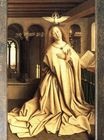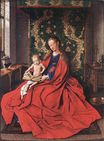Jan van Eyck - Virgin Annunciate, from the exterior of the right panel of the Ghent Altarpiece 1432
 |
 |
 |
 |
 |
 |
 |

Virgin Annunciate, from the exterior of the right panel of the Ghent Altarpiece 1432
165x73cm oil on wood
St. Bavo Cathedral, Ghent, Belgium
<< Previous G a l l e r y Next >>
From Wikipedia, the free encyclopedia:
The Ghent Altarpiece (or the Adoration of the Mystic Lamb, Dutch: Het Lam Gods) is a very large and complex 15th-century polyptych altarpiece in St Bavo's Cathedral, Ghent, Belgium. It was begun c. the mid-1420s and completed before 1432, and is attributed to the Early Netherlandish painters and brothers Hubert and Jan van Eyck. The altarpiece is considered a masterpiece of European art and one of the world's treasures.
Gabriel has blond hair and multicoloured wings. His right hand is raised and in his left he holds lilies, traditionally found in paintings of the annunciation as symbols of Mary's virginity. His words to Mary are written alongside him in Latin: AVE GRACIA PLENA D(OMI)N(U)S TECU(M) ("Hail who art full of grace, the Lord is with you"). The horizontal inscription extends out the panel and halfway across the neighbouring image. As in van Eyck's Washington Annunciation of c. 1434–6, the letters of Mary's reply are inscribed in reverse and upside-down; as if for God to read from heaven, or for the holy spirit, as represented by the dove, to read as he hovers directly above her. She answers ECCE ANCILLAM D(OMI)NI ("Behold the handmaiden of the Lord").